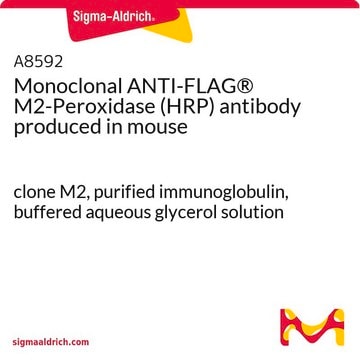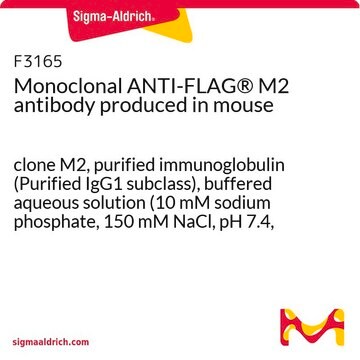11667475001
Roche
Anti-HA-Peroxidase
from mouse IgG2bκ
Synonym(s):
antibody
Sign Into View Organizational & Contract Pricing
All Photos(1)
About This Item
UNSPSC Code:
12352200
Recommended Products
biological source
mouse
conjugate
peroxidase conjugate
antibody form
purified immunoglobulin
antibody product type
primary antibodies
clone
12CA5, monoclonal
Assay
≥95% (HPLC and SDS-PAGE)
form
solution
packaging
pkg of 50 μg (500 μl)
manufacturer/tradename
Roche
concentration
0.1 mg/mL
isotype
IgG2bκ
epitope sequence
YPYDVPDYA
storage temp.
−20°C
General description
Anti-HA-Peroxidase is a monoclonal antibody to the HA peptide, conjugated to peroxidase. Anti-HA-Peroxidase recognizes the HA nonapeptide sequence (YPYDVPDYA), derived from the human influenza virus hemagglutinin protein (amino acids 98-106). The antibody recognizes its antigenic determinant even when the HA peptide epitope is introduced into unrelated recombinant proteins by a technique known as "epitope tagging".
Specificity
Anti-HA-Peroxidase recognizes the 9-amino acid sequence YPYDVPDYA, derived from the human influenza hemagglutinin (HA) protein. This epitope is also recognized in fusion proteins regardless of its position (N-terminal, C-terminal or internal).
The antibody reacts with the HA epitope, a nonapeptide sequence (YPYDVPDYA) derived from the influenza hemagglutinin protein.
Immunogen
Amino acids 98-106 from the human influenza virus hemagglutinin protein
Application
- Use Anti-HA-Peroxidase for the immunochemical detection of native influenza hemagglutinin protein and recombinant HA-tagged proteins using:
- Dot blot
- Western blot
Note: For experiments in which sensitivity is not critical, use Anti-HA-Peroxidase (12CA5). For higher sensitivity detection in western blotting at 10-fold lower concentration, use Anti-HA High Affinity.
Quality
Each lot of Anti-HA antibody is tested for functionality and purity relative to a reference standard to confirm the quality of each new reagent preparation.
Preparation Note
Stabilizers: BSA, sucrose, 0.02% thymol
Working concentration: Working concentration of conjugate depends on application and substrate.
The following concentrations should be taken as a guideline:
Working solution: 20-fold dilution of Western Blocking Reagent in 1x PBS.
Working concentration: Working concentration of conjugate depends on application and substrate.
The following concentrations should be taken as a guideline:
- Western blot: 0.1 μg/ml
Working solution: 20-fold dilution of Western Blocking Reagent in 1x PBS.
Other Notes
For life science research only. Not for use in diagnostic procedures.
Not finding the right product?
Try our Product Selector Tool.
Storage Class Code
12 - Non Combustible Liquids
WGK
WGK 1
Flash Point(F)
does not flash
Flash Point(C)
does not flash
Choose from one of the most recent versions:
Already Own This Product?
Find documentation for the products that you have recently purchased in the Document Library.
Customers Also Viewed
Asvin K K Lakkaraju et al.
Molecular biology of the cell, 23(14), 2712-2722 (2012-06-01)
Mammalian cells secrete a large number of small proteins, but their mode of translocation into the endoplasmic reticulum is not fully understood. Cotranslational translocation was expected to be inefficient due to the small time window for signal sequence recognition by
Sonia V del Rincón et al.
Oncogene, 23(57), 9269-9279 (2004-11-02)
Insulin receptor substrate-1 (IRS-1) mediates signaling from the insulin-like growth factor type-I receptor. We found that all-trans retinoic acid (RA) decreases IRS-1 protein levels in MCF-7, T47-D, and ZR75.1 breast cancer cells, which are growth arrested by RA, but not
Cigdem Aydin et al.
BMC cancer, 10, 584-584 (2010-10-28)
Lung cancer causes the highest rate of cancer-related deaths both in men and women. As many current treatment modalities are inadequate in increasing patient survival, new therapeutic strategies are required. TNF-related apoptosis-inducing ligand (TRAIL) selectively induces apoptosis in tumor cells
Marta García-León et al.
The Plant cell, 31(10), 2411-2429 (2019-08-01)
The plant endosomal trafficking pathway controls the abundance of membrane-associated soluble proteins, as shown for abscisic acid (ABA) receptors of the PYRABACTIN RESISTANCE1/PYR1-LIKE/REGULATORY COMPONENTS OF ABA RECEPTORS (PYR/PYL/RCAR) family. ABA receptor targeting for vacuolar degradation occurs through the late endosome
Helen Wedegaertner et al.
Molecular biology of the cell, 34(9), ar93-ar93 (2023-05-24)
The α-arrestin ARRDC3 is a recently discovered tumor suppressor in invasive breast cancer that functions as a multifaceted adaptor protein to control protein trafficking and cellular signaling. However, the molecular mechanisms that control ARRDC3 function are unknown. Other arrestins are
Our team of scientists has experience in all areas of research including Life Science, Material Science, Chemical Synthesis, Chromatography, Analytical and many others.
Contact Technical Service











